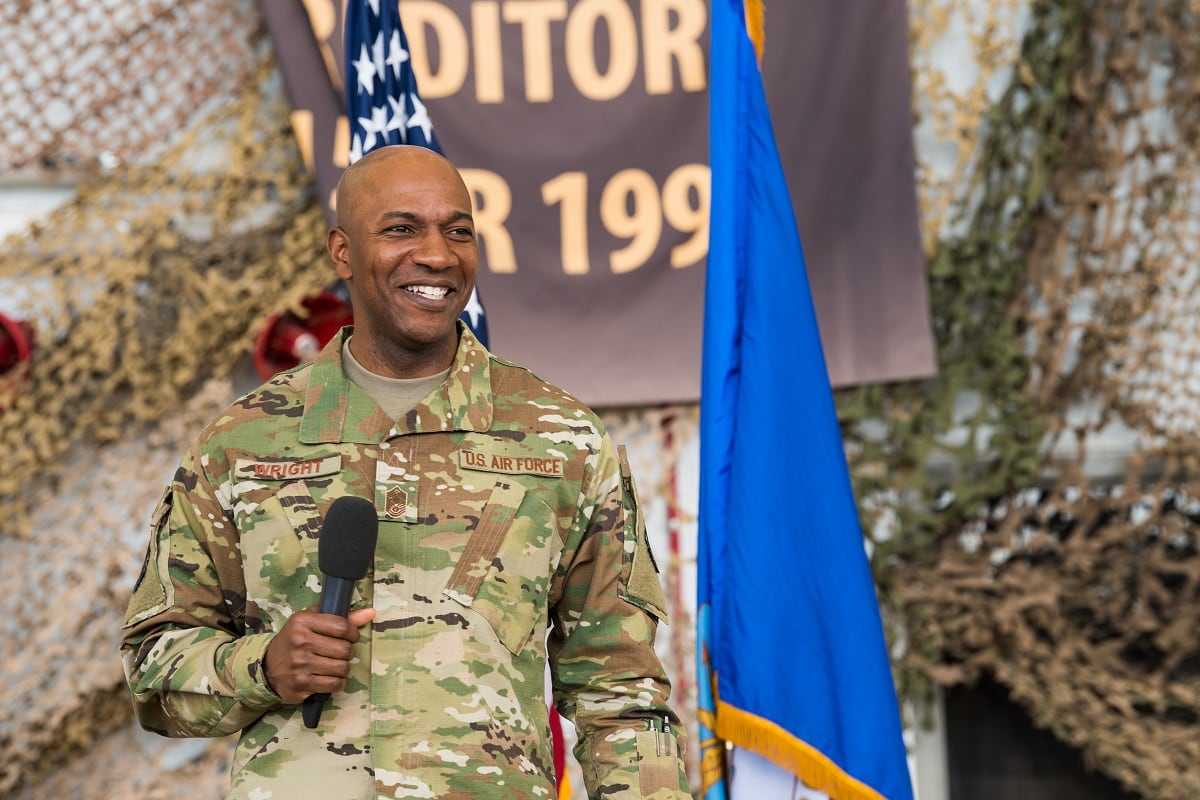Airmen can begin donning their new Operational Camouflage Pattern uniforms beginning Oct. 1.
Some airmen already wear the OCP part-time, such as those deployed to the Middle East, Air Force Global Strike Command security forces, and members of Air Force Special Operations Command.
But on Oct. 1, airmen across the force can transition to wearing OCPs full-time.
As for the Airman Battle Uniform, known as ABUs, airmen can continue wearing that uniform over the next three years. But by April 1, 2021, all airmen will be required to wear the OCP.
The service issued an update in July to Air Force Instruction 36-2903, “Dress and Personal Appearance of Air Force Personnel,” in order to address how the new uniform should be worn.
“OCPs purchased by Air Force personnel through the Army Air Force Exchange Stores (AAFES), Military Clothing Sales Stores (MCSS), or issued through Individual Equipment Elements or contract equivalent, are certified as fully compliant with all specifications. No other suppliers are approved for organizational/unit purchases,” according to the updated AFI.
October marks the beginning of the “optional wear” phase of the OCP roll-out, and select AAFES stores at a few bases will sell the new pattern. Those include Aviano Air Base in Italy, Joint Base Charleston in South Carolina, MacDill Air Force Base in Florida, and Shaw Air Force Base in South Carolina.
The Air Force will expand from there, as the Defense Logistics Agency ramps up the uniform’s production.
More AAFES stores will get the OCP pattern in April 2019, and by October 2019, airmen coming through basic training, officer training school, and the Reserve Officer Training Corps will be issued OCPs.
RELATED

AAFES is expected to start selling OCPs online next October as well.
By June 2020, all airmen must transition to coyote brown boots. The old sage green boots, which most airmen wear with their ABUs, or desert sand boots, worn by some who already have OCPs, will no longer be allowed. And finally, by April 2021, all airmen will be wearing OCPs.
Here is a quick run-down of some new OCP regulations per the updated AFI:
- Commanders may authorize sleeves to be rolled up on the OCP coat; however, the cuffs will remain visible and the sleeve will rest at, or within 1 inch of, the forearm when the arm is bent at a 90-degree angle. Regardless as to whether the sleeves are rolled up or unrolled, the cuffs will remain visible at all times.
- Patches or badges will not be affixed to the front pockets.
- Alterations that affect the functionality of the uniform are not authorized, e.g., sewing down collars, or pockets.
- The OCP coat may be removed in the immediate work area as determined appropriate by local leadership, however, the OCP coat will be worn while interacting with customers/clients.
- Airmen will wear a basic configuration until organizational patches and badges are developed or reconfigured.
- Airmen may sew-on or use velcro backing for U.S. Air Force tape, name tape and rank. Tapes and rank must be either all sewn-on or all velcro; Airmen are not authorized to mix sew-on and velcro tapes or rank. Only velcro patches are authorized on the left and right sleeves of the OCP coat.
- Rank Insignia is mandatory for all personnel
- Effective April 1, 2019, officer rank insignia will be spice brown; first lieutenant and lieutenant colonel rank insignia will be black. Enlisted rank will be spice brown. Name and U.S. Air Force tapes are mandatory for all personnel, and will be spice brown.
- Occupational badges may be worn centered ½ inch above the U.S. Air Force tape using spice brown embroidery on the OCP background. A maximum of two badges may be worn. The badge representing an airman’s current position will be worn first and a second badge is optional. Any other occupational or qualification badges and patches are optional.
- Unit commanders may authorize airmen to wear awarded U.S. Army shoulder sleeve insignia for former wartime service, such as the 82nd Airborne patch.
- Joint qualification tabs may be worn above the unit patch as a third patch, for instance the Army Ranger, Sapper, Air Commando and SERE patches.
The Air Force will increase airmen’s clothing allowance this fall by roughly $20 to match the increased price of the OCP design, Maj. Gen. Robert LaBrutta, the Air Force’s director of military force management policy, told Air Force Times in a May interview. The new boots will roughly match the price of the older, sage green boots worn with ABUs.
The OCP was chosen for three reasons: Its improved fit and comfort will make it easier for airmen to do their jobs, it will help airmen fit in alongside soldiers in the field and improve joint integration, and airmen consistently said they wanted the switch.
“We spoke to and listened to airmen on this, and the OCP was the clear choice," Air Force Chief of Staff Gen. Dave Goldfein said in a press release announcing the uniform change. "The uniform works in all climates ― from Minot to Manbij ― and across the spectrum of missions we perform. It’s suitable for our airmen working on a flight line in Northern Tier states and for those conducting patrols in the Middle East.”
Kyle Rempfer was an editor and reporter who has covered combat operations, criminal cases, foreign military assistance and training accidents. Before entering journalism, Kyle served in U.S. Air Force Special Tactics and deployed in 2014 to Paktika Province, Afghanistan, and Baghdad, Iraq.




